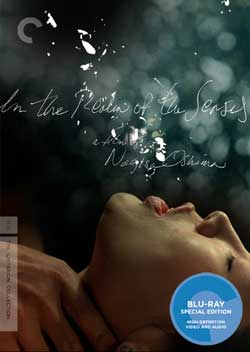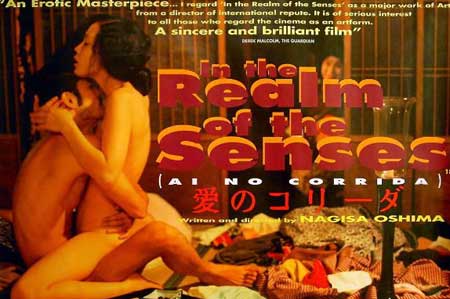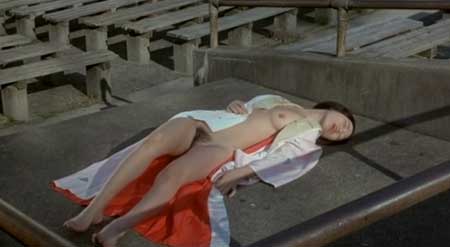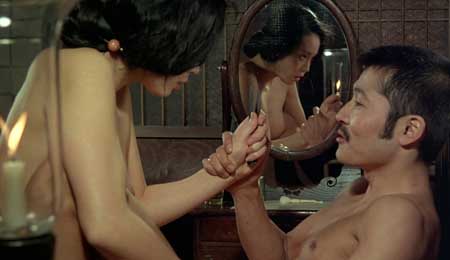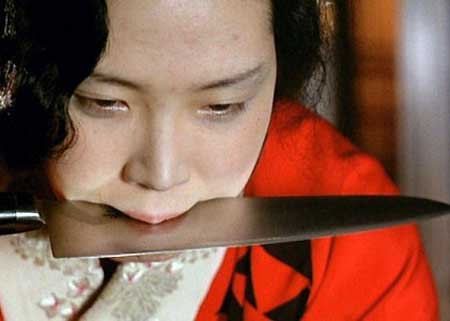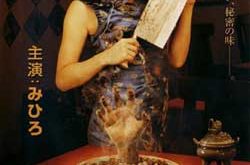SYNOPSIS:
In The Realm of the Senses is based upon a real-life incident which took place in Japan on 17th May 1936. This incident was the particularly gruesome murder of Kichizo Ishida by his lover, Abe Sada: after having choked Ishida to death, Sada cut off his penis and carried it around with her until she was caught two days later. Oshima’s film centres on the love affair between Ishida and Sada portraying their sexual relations in a graphic detail, and its explicit nature led to some critics dismissing In The Realm of the Senses as p*rnography and the outright banning of the film in a number of countries on release.
REVIEW:
The case of Abe Sada has entered in cultural mythology in Japan, and has become shorthand for the dangerous passions of a woman scorned with Sada one of the most famous real-life dokufu (poison women), whose uncontrolled sexuality is a literal embodiment of Barbara Creed’s concept of the ‘monstrous feminine’ (1992). However having said this, Sada only spent 4 years in jail and was not the subject of outright condemnation on her release. Indeed her story has since provided the subject matter for many literary, journalistic and screen texts including an interview and appearance by Sada in Ishi’s Love and Crime (1969), a compilation of various real life tales of violent and murderous femininity including of course that of Sada. Earlier in the year, Noboru Tanaka released his own and tamer version of the story, A Woman Called Abe Sada which presents Sada as a more fully rounded character than in Oshima’s version where she exists purely in a sexual place of couplings, orgies and sexual obsession. There have been a number of other variations on the story since, with Kyoko Aizome’s 2011 Abe Sada: Saigo no nanokakan, the most recent but none has received the critical acclaim of Oshima’s film.
Widely lauded as a cinematic tour-de-force by some critics and dismissed as p*rnography by others, In The Realm of the Senses continues to be a divisive text. Certainly while the content is explicit, the aesthetics of Oshima’s carefully composed mise-en-scene of passion situate In The Realm of the Senses as art rather than [sex] exploitation cinema.
Even if the conditions of arousal are met – the raison d’être of p*rnography – the narrative of death and desire, which perhaps proves Freud’s point about penis-envy, means that any tumescence that is aroused is eventually deflated by savage cut of Sada’s knife. At the same time, by presenting Sada as becoming increasing sexually obsessed with Ishida’s penis – as shown by multiple scenes in which close-ups of Sada manhandling the said penis with propriety rights foreground her attachment not to Ishida himself but rather to the ‘penis’, the object of pleasure and penetration – the film reinforces dominant heterosexuality and male privilege by suggesting that the penis is the ultimate object of [female] desire. Indeed towards the brutal end of the affair, Sada spends a whole night holding it, talking to it and indeed is distressed when the loved object is about to be out of her sight when Ishida wants to relieve himself. Ishida comments when Sada attempts to prevent him leaving that it (the penis) ‘practically belongs to you’. Sada’s response ‘you’re right, it does belong to me, is telling, especially in light of later events. Indeed the real life Sada attempted both fellatio and penetration with her lover’s dismembered penis before her arrest. Of course, a flaccid organ is neither use nor ornament, as Sada herself was to discover.
While there is much to admire about the visual imagery contained within a cinematic palate of sumptuous reds, blues and yellows and the sonic soundscape – which includes the frequent punctuation of the soundtrack by traditional Japanese music – the representation of Sada as the typical sexually insatiable and voracious woman found both in Japanese pink cinema as well as Western p*rnography of the time, sits uncomfortably with me. While I can appreciate the aesthetics and the frequent pointed critiques of the hypocrisy of the Japanese censorship system – which forbade the ‘horrific’ sight of pubic hair – at one point Sada plucks the pubic hair from Ishida and eats it – I find the relationship between the two lovers is not convincing and therefore am unable to connect emotionally, a necessary condition of engagement with a romantic cinematic romance, even one with a suitably grotesque conclusion. Perhaps, there was just too much sex, not enough love and too little gore, for my personal tastes. And not to forget too much forced sex, a problematic staple of Japanese pink cinema and for which I can find no justification. Women enjoying being forcibly penetrated sends out a message that no actually means yes and that all women need to feel the force of patriarchal power in order to be fulfilled. Ugh.
Having said this, I can understand why In The Realm of the Senses has appealed to critics and viewers alike, it is sumptuous, decadent and orientalist enough for both the Western and Eastern viewer. Oshima was one of Japanese cinema’s most important and prolific directors, but I don’t ‘get’ In The Realm of the Senses. I think that its skewed view of male and female relationships is unhealthy even given the fact the act of viewing is integrated into the diegesis itself and therefore provides a meta-commentary on the act of spectatorship through which the private becomes public. Just as psychoanalysis couldn’t discover what women want, or what women desire – and yes, I am talking about you, Freud, and you, Lacan, male director’s attempts to pin down female sexuality are no more successful, and it is this obsession with what women desire – THE PENIS – that I am finding myself increasingly tired of. In The Realm of the Senses takes this obsession to extreme lengths, Sada is frequently referred to as a vampire, a parasite who sucks out the energy of her victim, her uncanny whiteness and radiant youth and voracious appetite construct her as the epitome of the poison woman – an object of both desire and fear for the male viewer.
I much prefer Oshima’s counterpoint to In The Realm of The Senses, Empire of Passion (1978) in which the relationship between Toyoji and Seki is beautifully and compassionately realised. But at the end of the day, it is a matter of taste, and of course, I prefer ghosts and ghouls to sadistic women and masochistic men.
 Horror News | HNN Official Site | Horror Movies,Trailers, Reviews
Horror News | HNN Official Site | Horror Movies,Trailers, Reviews
